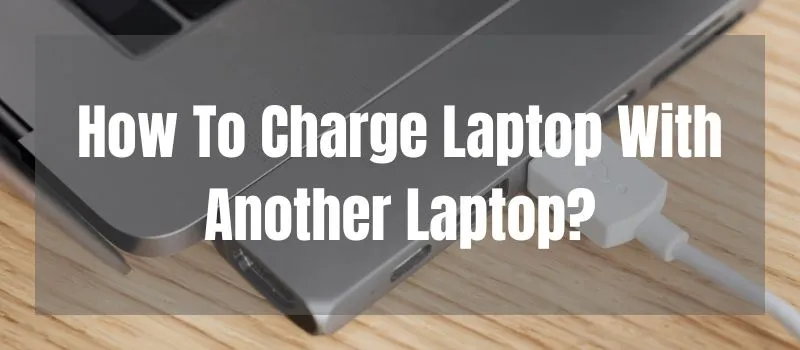Do you need to juice up your laptop but there’s no power outlet in sight? Have no fear! We’ve got an answer for you. In case you’ve ever wondered, How to charge laptop with another laptop? The answer is yes. The encouraging news is that it can be done.
We will discuss the process of recharging one laptop from another and will provide detailed advice on how to do it. A USB-C cable and a laptop with a power delivery (PD) feature are required to charge one laptop from another.
You may charge one laptop by plugging it into the other using the USB-C cord. It’s a quick and easy solution to the problem of how to keep your laptop charged when you’re on the go. The topic of laptop charging isn’t quite over though.
We’ll discuss the drawbacks, if any, of using one laptop to charge another, and the necessary interoperability between the two devices. We’ll go through some insider recommendations for streamlining the charging procedure for maximum convenience.
If you’re interested in learning about a viable laptop power alternative, let’s go into the area of charging computers with other laptops.
Table of Contents
How To Charge Laptop With Another Laptop?
Your laptop can be charged using another laptop if you’re wondering whether it’s possible. Keep in mind, there are a few requirements. A USB-C port must be present on your laptop, which can be found on most modern laptops.
The standard USB ports, like USB-A, won’t suffice for this purpose. USB-C is the key to enabling power transfer between laptops. To charge your laptop with another laptop, you’ll need a USB-C cable.
Connect the USB-C ports of both laptops using the cable, and you’re all set. The laptop supplying the power must support power delivery (PD), which is a feature that allows it to provide power through the USB-C port.
This method of charging offers convenience, especially when you don’t have access to a power outlet. It’s a helpful solution for emergencies or when you’re on the go. Just ensure that the laptop providing the power is adequately charged to avoid draining both devices.
Charging your laptop with another laptop is possible with the right setup. As long as both laptops have USB-C ports and the supplying laptop supports power delivery, you can transfer power between them using a USB-C cable.
It’s a practical solution that offers flexibility in various situations. Stay powered up wherever you are with this handy method of laptop charging.
Using A USB-C Cable
One of the most common and convenient methods to charge a laptop with another laptop is by using a USB-C cable. Many modern laptops are equipped with USB-C ports, which support power delivery. Follow these steps to charge your laptop using a USB-C cable:
- Connect the USB-C cable to the charging laptop’s USB-C port.
- Plug the other end of the USB-C cable into the receiving laptop’s USB-C port.
- Ensure that both laptops are powered on and unlocked.
- The charging laptop should detect the connected laptop and start supplying power.
It’s important to note that not all USB-C cables support power delivery, so make sure you have a cable that is specifically designed for charging purposes.
Sharing Power Through AC Outlet
Another method to charge a laptop with another laptop is by using an AC outlet. This method requires an AC power inverter, which can convert the DC power from the charging laptop into AC power that can be plugged into an outlet. Follow these steps to charge your laptop using an AC outlet:
- Connect the AC power inverter to the charging laptop’s DC power output.
- Plug the AC power inverter into a wall outlet.
- Ensure that both laptops are powered on and unlocked.
- The charging laptop will convert its DC power into AC power, which can then be used to charge the receiving laptop.
Using an AC power inverter provides a more traditional charging method, but it may require additional equipment and can be less portable compared to the USB-C cable method.
How Does Laptop Charging Work?
AC (alternating current) power conversion is the mechanism through which a laptop can be charged. Your laptop’s charger establishes contact with an electrical source that delivers alternating current when plugged into a wall socket.
The charger then alters the incoming alternating current to the direct current (DC) that your laptop can use. Transformers, rectifiers, and capacitors make up the internal circuitry of the charger.
The purpose of a transformer is to reduce the high voltage of the AC electricity coming from the wall socket so that it can be safely used by your laptop. The electrical signal is rectified from alternating current to direct current via a rectifier.
By compensating for voltage and current spikes and dips, capacitors ensure that your laptop runs smoothly at all times. The laptop’s charging port receives DC electricity via the cable once it has been created by the charger.
Your laptop’s battery can be charged using this port because it was made to accept its required voltage and current. It controls the flow of electricity into the laptop and routes it to the charging circuitry within.
The charging process is controlled by a circuit within your laptop. It regulates the charging current and voltage to keep the battery in good condition during the process. Multiple cells store and release electricity to function as the battery.
When a battery is charged, chemical reactions take place within its cells, allowing energy to be stored until it is needed. Charging a laptop requires a number of sophisticated steps, including changing the incoming alternating current from the wall socket into the direct current, regulating the voltage and current, and providing power to the battery. It frees your laptop from its tethered existence, letting you work wherever you happen to be.
Can I Charge Any Laptop With Another Laptop?
Yes, it is possible to charge one laptop with another laptop under certain conditions. Some laptops are equipped with USB Type-C ports that support Power Delivery (PD) technology. If both laptops have such ports, you can use a USB Type-C cable to connect them, allowing power to flow from one laptop to the other.
Not all laptops have this capability, and even if they do, the amount of power that can be transferred may be low. The laptop charger must be able to supply enough juice for both devices. The charging procedure is more efficient if the laptop is in low-power mode or off while it is being charged.
It’s important to note that charging one laptop from another is not the most energy-efficient option. Because of the higher wattage and faster charging speeds that wall chargers provide, they are the chargers of choice for laptops.
This means that, whenever possible, you should use the charger that was specifically designed for your laptop. Make sure you follow any manufacturer-provided instructions for charging your laptop over USB Type-C, and check the handbook or specifications to see if that feature is supported.
FAQs
Can I charge a Windows laptop with a Mac laptop?
Yes, it is possible to charge a Windows laptop with a Mac laptop, provided both laptops have the necessary ports and power delivery capabilities. Make sure to use the appropriate cables and adapters to ensure compatibility.
Is it safe to charge a laptop with another laptop?
Charging a laptop with another laptop is generally safe as long as you use the correct cables and adapters. It’s essential to exercise caution and ensure that both laptops are not overheating during the charging process. If you notice any unusual behavior or excessive heat, disconnect the charging cable immediately.
Can I charge a gaming laptop with another laptop?
Yes, you can charge a gaming laptop with another laptop, as long as both laptops have the necessary ports and power capabilities. Gaming laptops typically require more power, so ensure that the charging laptop can provide sufficient power output.
Are there any risks involved in charging a laptop with another laptop?
While charging a laptop with another laptop is generally safe, there are a few potential risks to be aware of. Using incompatible cables or adapters can lead to electrical issues, and charging laptops for an extended period may strain the battery life of both devices. It’s always recommended to follow the manufacturer’s guidelines and ensure compatibility between the devices.
Can I charge a laptop with a smartphone?
Charging a laptop with a smartphone is not a recommended method. Smartphones are designed to provide power output, not receive it. Attempting to charge a laptop with a smartphone may damage both devices and pose a safety risk.
What are the advantages of charging a laptop with another laptop?
Charging a laptop with another laptop offers several advantages. It provides a portable and convenient solution when you don’t have access to a power outlet. It can serve as a backup power source during emergencies or while traveling.
Conclusion
When you’re out of battery life and without access to a power outlet, knowing how to charge a laptop with another laptop can be a lifesaver. You need to ensure compatibility between the devices and use the correct cables and adapters, whether you use a USB-C cable or an AC power inverter.
To prevent any potential risks, monitor the charging process carefully. Your laptop can be powered up wherever you are with these methods at your disposal.
Read More:




